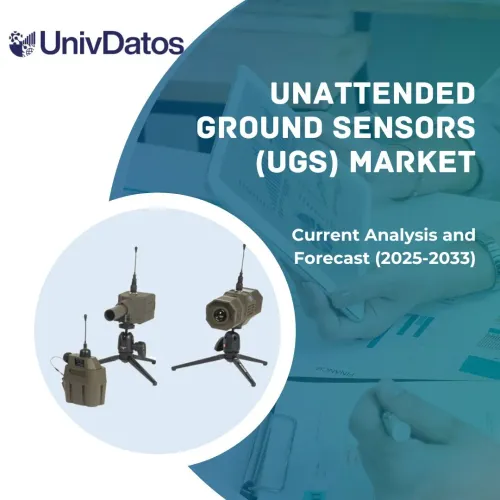- Home
- About Us
- Industry
- Services
- Reading
- Contact Us
Motion Control Market: Current Analysis and Forecast (2024-2032)
Emphasis on Offering (Actuators and Mechanical Systems, Drive, Motors, Motion Controllers, Sensors and Feedback Services, and Software and Services); System (Open-loop System and Closed-loop System); Industry (Aerospace and Defense, Automotive, Metals & Machinery Manufacturing, Healthcare, Semiconductors & Electronics, and Others); and Region/Country
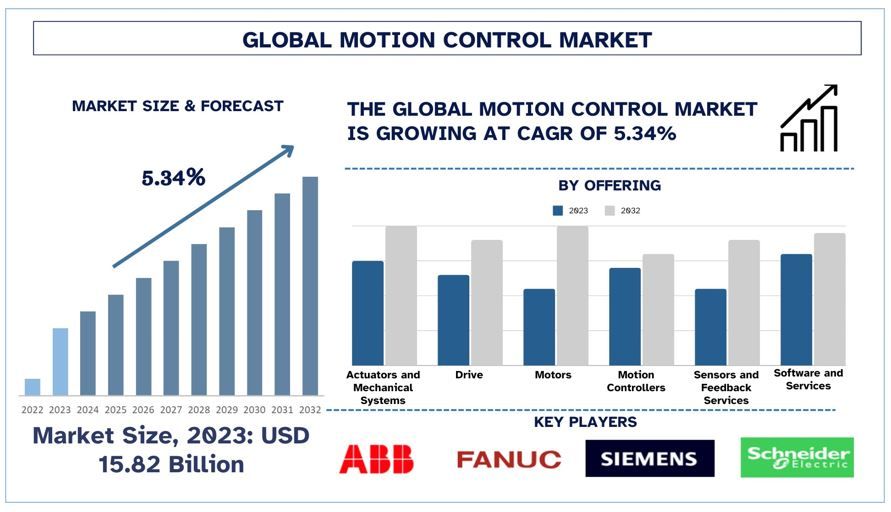
Motion Control Market Size & Forecast
The motion control market was valued at approximately USD 15.82 billion in 2023 and is expected to grow at a strong CAGR of around 5.34% during the forecast period (2024-2032) owing to the increasing demand for automation and energy-efficient solutions across various industries.
Motion Control Market Analysis
Motion control is the mechanism where the movement of machinery is done by using rotatory and linear actuators. It is the sub-field of the automation process, whereby position or velocity machines are being controlled with the help of devices such as electric motors, linear actuators, hydraulic pumps, or a servo motor. Motion control helps an organization to increase its consistency, boost the production level, and offer high speed, and greater accuracy, which leads to cost optimization.
The Motion Control Market is expected to grow at a steady rate of around 5.34%, owing to the growing need for increased manufacturing accuracy and efficiency through more energy usage. Also, the need for collaborative robots (cobots) with built-in motion control systems is growing, mainly because companies seek to gain efficiency to offset labor costs. However, the growing trend towards sustainability and rigorous energy use has boosted the uptake of motion control systems, particularly in the manufacturing process of electric vehicles where most robotic processes require high levels of accuracy.
Recent Developments in the Market:
- In February 2024, ABB launched the world’s first IE5 SynRM (synchronous reluctance motor) series with the launch of a new version that combines the benefits of ultra-premium energy efficiency with highly effective liquid cooling. The new design sets a new benchmark for high power output and reliability in a compact footprint. The newly launched motor is more efficient and reliable which optimizes the total cost of ownership (TCO) through lower energy consumption.
- In June 2022, Siemens expanded its portfolio in predictive maintenance and asset intelligence by acquiring Senseye. With the help of this acquisition, Siemens will be able to determine the future condition of their machinery and also help their customers across the industries, which enhances their overall equipment effectiveness.
Motion Control Market Trends
Adoption of IoT and Smart Systems
The adoption of IoT and Smart Systems is one of the major trends in the motion control market. This trend revolutionized the manufacturing process across industries and increased efficiencies in the production line. The integration of these technologies allows us to overcome challenges on time with the help of real-time monitoring and predictive maintenance.
- In April 2024, Siemens launched a new generation of controllers called Simatic S7-1200 G2, as a part of Siemens Xcelerator. By introducing this sense-formed controllers series, Siemens is not only extending its product portfolio but is also showing what these most current advancements can bring to its customers in terms of simplification in automation and programming. This is achieved through basic benefits in motion control, ease of implementing safety for any machine, higher performance as well as scalability.
- In June 2024, ABB launched its next-generation robotics control platform called OmniCore. The platform is launched to increase business productivity and flexibility through faster, more precise, and more autonomous automation. The platform is the result of a total investment of USD 170 million, which pushes the industry towards more automation.
These innovations are enhancing greater efficiency and throughput, lessening downtimes, and improving process control for manufacturers. These emerging technologies of IoT and Smart Systems in controlling motions are in harmony with the changing manufacturing industries called Industry 4.0.
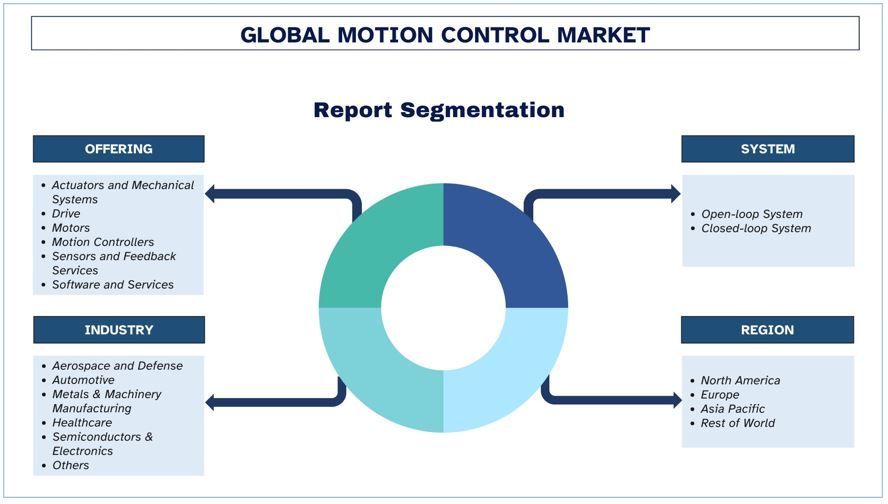
Asia-Pacific is expected to dominate the market during the forecast period
The Asia Pacific region held the majority share of the market in the year 2023 due to various factors such as the region being the emerging manufacturing hub. Factors such as the presence of the largest manufacturing companies due to cheap labor costs, and growing innovation parallelly supported the market growth. Countries such as China, India, Indonesia, and South Korea produce a wide range of vehicle components including battery management systems, drives, and motors. These components require efficient and reliable motors, which consequently drive the motion control market. Government support such as India’s PLI Scheme for automobiles and auto components which comes under the Department of Heavy Industries has boosted the production of machinery, further increasing the adoption of automation and robotics, therefore driving the motion control market. For instance, in 2023, according to the report published by IFR (International Federation of Robotics), a total of 553,052 industrial robot installations will be in factories around the world. Among them, 73% of all newly deployed robots were installed in Asia. This has fueled the demand for motion control in the region and is one of the most important factors for the domination of the global market. Japan is one of the most technologically advanced countries in terms of the automotive industry with the presence number of global automotive players such as Honda, Toyota, Nissan, and others. This will allow manufacturers to install technologically advanced solutions that optimize processes and reduce day-to-day expenses. To achieve this, companies need to install robotics mechanisms or cobots, which drive the motion control market. Moreover, according to the report published by JAMA (Japan Automobile Manufacturers Association, Inc.), with an increase in manufacturing, the country’s automotive shipments reached 63 trillion Yen in 2022, up 11.4% from the previous year. Moreover, the country has increased its exports to 4,422,682 units in 2023. Motor vehicle exports increased in 2023 from the previous year to North America (1.72 million units), Europe (775,100 units), the Middle East (490,000 units), Oceania (469,000 units), and Latin America (277,000 units), but decreased to Asia (575,000 units) and Africa (107,000 units). The increased production and export of vehicles boosted the demand for the market.
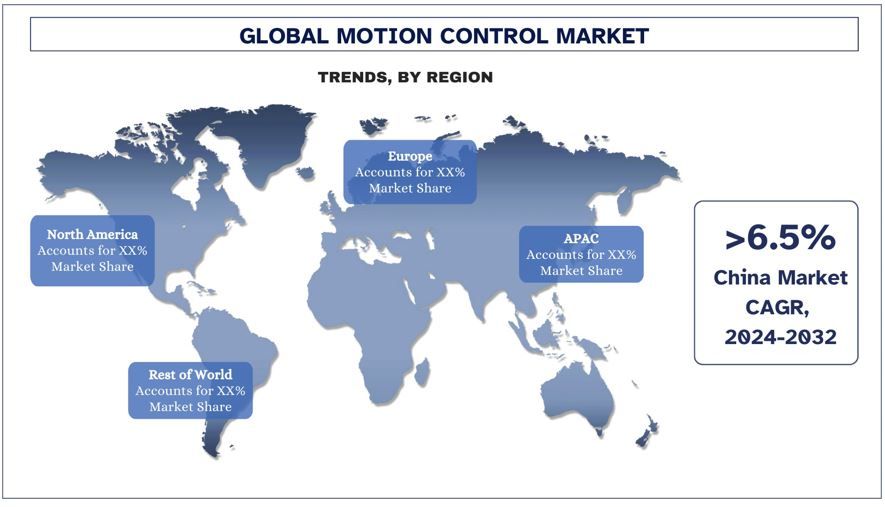
Motion Control Industry Overview
The motion control market is competitive, with several global and international market players. The key players are adopting different growth strategies to enhance their market presence, such as partnerships, agreements, collaborations, geographical expansions, and mergers and acquisitions. Some of the major players operating in the market are ABB, FANUC CORPORATION, Siemens, Schneider Electric, Rockwell Automation, Parker Hannifin Corporation, Bosch Rexroth Corporation, OMRON Corporation, Mitsubishi Electric Corporation, and STMicroelectronics.
- In January 2024, Siemens enhances the Sinamics S210 servo drive system in terms of new hardware and software for even broader application areas. Some of the latest features in the new V6 software generation include a single positioner that lightens the load of the controller as well as an EtherNet/IP interface for integration of third-party controllers. The servo drive system is especially suitable for applications with high dynamics in the power range between 50 W and 7 kW: For example, packaging machines, pick and place machines, digital printers, or any automated device.
Motion Control Market Report Coverage

Reasons to buy this report:
- The study includes market sizing and forecasting analysis validated by authenticated key industry experts.
- The report presents a quick review of overall industry performance at one glance.
- The report covers an in-depth analysis of prominent industry peers with a primary focus on key business financials, product portfolios, expansion strategies, and recent developments.
- Detailed examination of drivers, restraints, key trends, and opportunities prevailing in the industry.
- The study comprehensively covers the market across different segments.
- Deep dive regional level analysis of the industry.
Customization Options:
The global motion control market can further be customized as per the requirement or any other market segment. Besides this, UMI understands that you may have your own business needs, hence feel free to contact us to get a report that completely suits your requirements.
Table of Content
Research Methodology for the Motion Control Market Analysis (2024-2032)
Analyzing the historical market, estimating the current market, and forecasting the future market of the global motion control market were the three major steps undertaken to create and analyze the adoption of motion control in major regions globally. Exhaustive secondary research was conducted to collect the historical market numbers and estimate the current market size. Secondly, to validate these insights, numerous findings and assumptions were taken into consideration. Moreover, exhaustive primary interviews were also conducted, with industry experts across the value chain of the global motion control market. Post assumption and validation of market numbers through primary interviews, we employed a top-down/bottom-up approach to forecasting the complete market size. Thereafter, market breakdown and data triangulation methods were adopted to estimate and analyze the market size of segments and sub-segments of the industry pertains to. Detailed methodology is explained below:
Analysis of Historical Market Size
Step 1: In-Depth Study of Secondary Sources:
A detailed secondary study was conducted to obtain the historical market size of the motion control market through company internal sources such as annual reports & financial statements, performance presentations, press releases, etc., and external sources including journals, news & articles, government publications, competitor publications, sector reports, third-party database, and other credible publications.
Step 2: Market Segmentation:
After obtaining the historical market size of the motion control market, we conducted a detailed secondary analysis to gather historical market insights and share for different segments & sub-segments for major regions. Major segments are included in the report, such as offering, system, industry, and region. Further country-level analyses were conducted to evaluate the overall adoption of testing models in that region.
Step 3: Factor Analysis:
After acquiring the historical market size of different segments and sub-segments, we conducted a detailed factor analysis to estimate the current market size of the motion control market. Further, we conducted factor analysis using dependent and independent variables such as offering, system, industry, and regions of the motion control market. A thorough analysis was conducted of demand and supply-side scenarios considering top partnerships, mergers and acquisitions, business expansion, and product launches in the motion control market sector across the globe.
Current Market Size Estimate & Forecast
Current Market Sizing: Based on actionable insights from the above 3 steps, we arrived at the current market size, key players in the global motion control market, and market shares of the segments. All the required percentage shares split, and market breakdowns were determined using the above-mentioned secondary approach and were verified through primary interviews.
Estimation & Forecasting: For market estimation and forecast, weights were assigned to different factors including drivers & trends, restraints, and opportunities available for the stakeholders. After analyzing these factors, relevant forecasting techniques i.e., the top-down/bottom-up approach were applied to arrive at the market forecast for 2032 for different segments and sub-segments across the major markets globally. The research methodology adopted to estimate the market size encompasses:
- The industry’s market size, in terms of revenue (USD) and the adoption rate of the motion control market across the major markets domestically.
- All percentage shares, splits, and breakdowns of market segments and sub-segments.
- Key players in the global motion control market in terms of products offered. Also, the growth strategies adopted by these players to compete in the fast-growing market.
Market Size and Share Validation
Primary Research: In-depth interviews were conducted with the Key Opinion Leaders (KOLs) including Top Level Executives (CXO/VPs, Sales Head, Marketing Head, Operational Head, Regional Head, Country Head, etc.) across major regions. Primary research findings were then summarized, and statistical analysis was performed to prove the stated hypothesis. Inputs from primary research were consolidated with secondary findings, hence turning information into actionable insights.
Split of Primary Participants in Different Regions
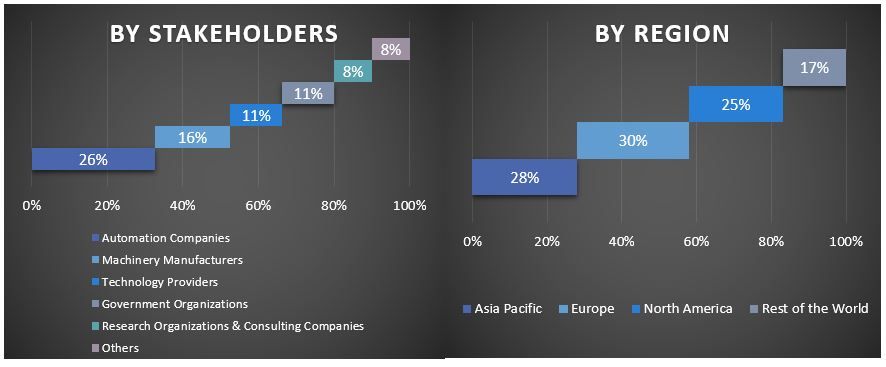
Market Engineering
The data triangulation technique was employed to complete the overall market estimation and to arrive at precise statistical numbers for each segment and sub-segment of the global motion control market. Data was split into several segments and sub-segments after studying various parameters and trends in the areas of offering, system, industry, and regions in the global motion control market.
The main objective of the Global Motion Control Market Study
The current & future market trends of the global motion control market were pinpointed in the study. Investors can gain strategic insights to base their discretion for investments on the qualitative and quantitative analysis performed in the study. Current and future market trends determined the overall attractiveness of the market at a regional level, providing a platform for the industrial participant to exploit the untapped market to benefit from a first-mover advantage. Other quantitative goals of the studies include:
- Analyze the current and forecast market size of the motion control market in terms of value (USD). Also, analyze the current and forecast market size of different segments and sub-segments.
- Segments in the study include areas of the offering, system, industry, and regions.
- Define and analyze the regulatory framework for the motion control
- Analyze the value chain involved with the presence of various intermediaries, along with analyzing customer and competitor behaviors of the industry.
- Analyze the current and forecast market size of the motion control market for the major region.
- Major countries of regions studied in the report include Asia Pacific, Europe, North America, and the Rest of the World
- Company profiles of the motion control market and the growth strategies adopted by the market players to sustain in the fast-growing market.
- Deep dive regional level analysis of the industry.
Frequently Asked Questions FAQs
Q1: What is the motion control market's current market size and growth potential?
Q2: What are the driving factors for the growth of the motion control market?
Q3: Which segment has the largest share of the motion control market by offering?
Q4: What are the emerging technologies and trends in the motion control market?
Q5: Which region will dominate the motion control market?
Related Reports
Customers who bought this item also bought




